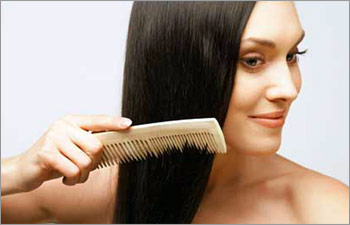Jojoba oil is actually a yellow colored wax extracted from the seeds of Simmondsia chinensis, a woody shrub native to Mexico.
Due to its similarities to the skin's natural oils, its high vitamin content, and antimicrobial properties, jojoba oil is the perfect product to protect and nurture skin and hair. Here are a few of the things jojoba oil can do for you.
1. Makeup remover and general skin cleanser
Use a few drops of jojoba oil of a cotton pad to remove the makeup from your face and around your eyes. It will leave your skin smooth and silky, and because it's completely natural and free of harmful chemicals, it will not irritate your eyes at all. |
| Desert Essence Organic Jojoba Oil |
2. Anti-aging treatment
Jojoba oil is rich in vitamin E, copper and zinc and antioxidants, which fight free radicals and help maintain your skin young and wrinkle-free. Dab a few drops of jojoba oil around your eyes and on your forehead in order to prevent the formation of wrinkles.3. Moisturizer
You can use jojoba oil as a day and night moisturizer. Apply a few drops of jojoba oil on your skin, and massage it in just like you would with any cream. Due to its easy spreadability, you won't have to use much. If there is an excess of oil left on your skin, blot it off using a tissue. |
| Melvita Jojoba Oil |
4. Anti-acne treatment
Because it is so similar to the skin's natural oils, jojoba oil can trick your skin into thinking it has produced enough sebum, thereby restoring its natural balance. Jojoba oil is also non-comedogenic, which means it will not clog your pores and cause further breakouts. Its anti-microbial properties are an added bonus in your fight against acne.5. Shaving lotion
Massaging jojoba oil onto your legs before shaving will ensure a smooth, easy shave, without the razor burn and irritation that can follow with other products. It will also leave your legs hydrated and feeling silky.6. Hair treatment
Because it is a wax and not actual oil, jojoba oil applied on your hair will detangle and condition it without a greasy feeling. A jojoba oil hair mask a few hours before a shower can moisturize and revitalize dull and dry hair, making it soft and easy to comb.The anti-microbial properties of jojoba oil can help get rid of dandruff and general scalp irritation.
 |
| LOGONA Jojoba Hair Repair Treatment |
7. Body lotion
If it's good for your face and skin, then why not for your entire body? Massage a few drops of jojoba oil into your skin after showering, just like you would any oil or lotion, in order to lock the moisture in and have healthy, hydrated skin. |
| Jurlique Jojoba Carrier Oil |
Jojoba oil is a natural product that is rich in vitamins and antioxidants. Its strong similarity to the skin's natural oils makes it a great skin product for any types of skin. It can be used as a skin cleanser, moisturizer and acne treatment. Jojoba oil is the ideal product which can substitute almost any products in your beauty routine.























